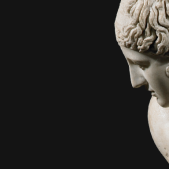
British Museum: Exhibition for the ideal body in ancient Greek art
A new exhibition opened on March 26, 2015 at the British Museum entitled «Defining Beauty: the body in ancient Greek art». The visitor experiences the brilliance and diversity of ancient Greek art in this major exhibition focusing on the human body with a stunning array of sculptures and ceramics that includes some of the most familiar works of Greek antiquity.
The remarkable works of art in the exhibition range from abstract simplicity of prehistoric figurines to breathtaking realism in the age of Alexander the Great. These works continued to inspire artists for hundreds of years, giving form to thought and shaping our own perceptions of ourselves. The nude sculptures of the ancient Greeks depict what they believed to be the perfect human form, and the results still dazzle and move us thousands of years on, as the British Museum’s latest exhibition demonstrates.
For centuries the ancient Greeks experimented with ways of representing the human body, both as an object of beauty and a bearer of meaning. The exhibition also compares how other cultures treated the human form and their attitudes to nudity, from the Mayans to the Assyrians.
«The Greeks invented the human being,» Ian Jenkins, the exhibition’s curator, said, pointing to Greek philosophy, mythology and democracy, not just the aesthetics of the sculptures that dominate the exhibition.
The exhibition opens with the striking view of a nude goddess Aphrodite from behind. When visitors walk around the statue, they are met with her guarded, threatening gaze. Though Greek in origin, she is a Roman copy. So is the discus thrower, Myron’s Diskobolos, a study in the perfect «balance of opposites».
But museum does display its own prized Greek originals which are the source of a long-running dispute with Greece. Athens has repeatedly called for the return of marble statues from the Parthenon, which were taken by Elgin from Greece in 1816.
Among the surprises in the British Museum’s exhibition on Greek sculpture is an important early 20th century bronze copy which most archaeologists assumed had been destroyed during the Second World War. It is a reconstruction of the famous Doryphoros (spear-bearer), made in around 1920 by the German sculptor Georg Römer. He based it on three Roman marble copies of the lost Greek original by Polykleitos of around 440 to 430 BC.
In addition, an extraordinary life-sized bronze sculpture of a young athlete (the “apoxyomenos”) that was recovered in 1999 from the depths of the Adriatic Sea will be a part of the exhibition. The youth seems lost in concentration, but is perhaps not unaware that his beauty will attract admiration.
Part of the Parthenon’s frieze and the statue of Ilissos, recently returned from Russia, are on display and are a highlight of the exhibition.











